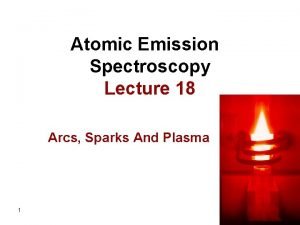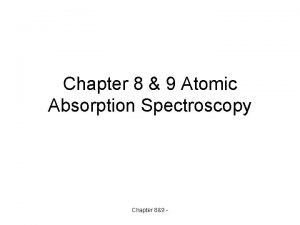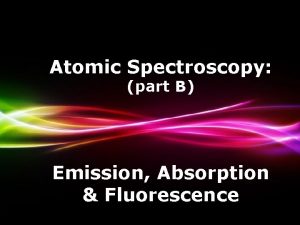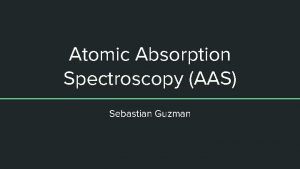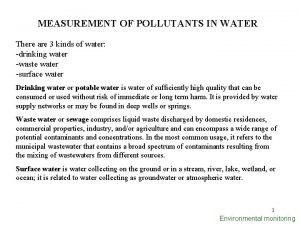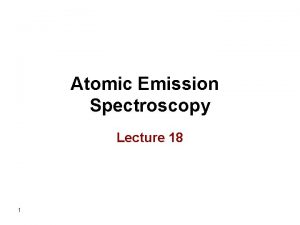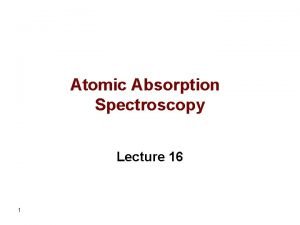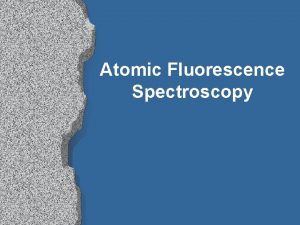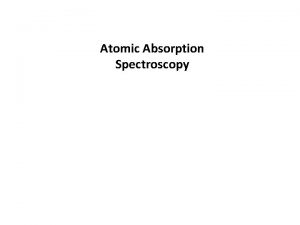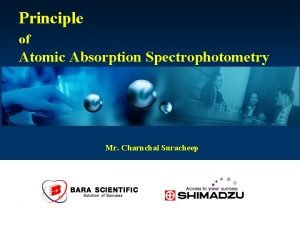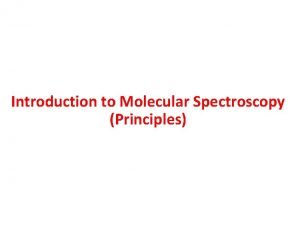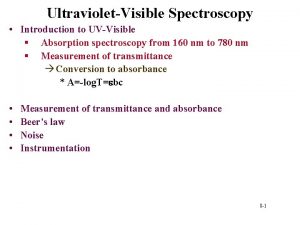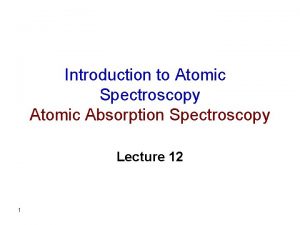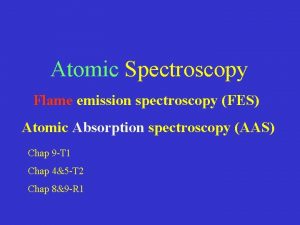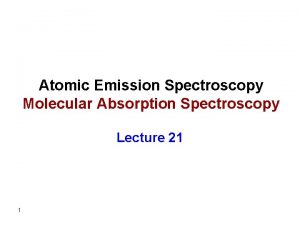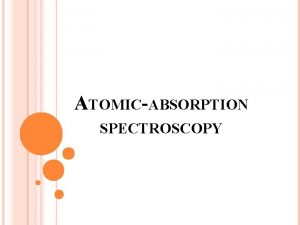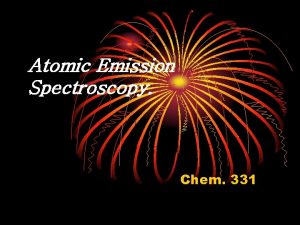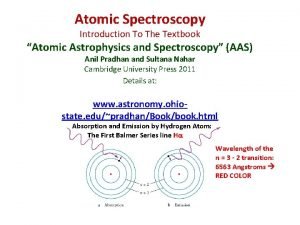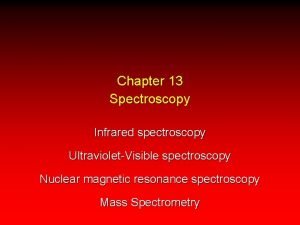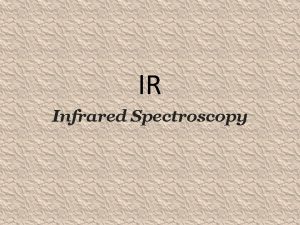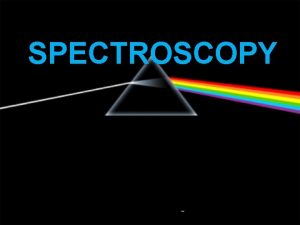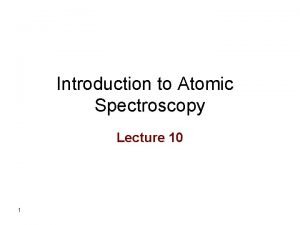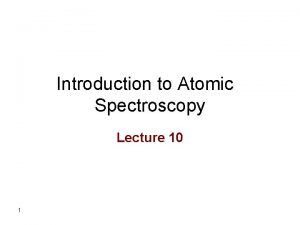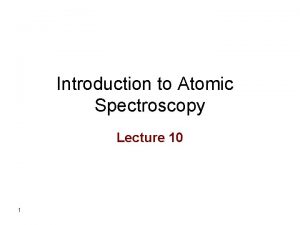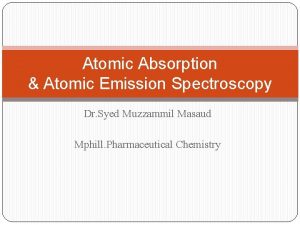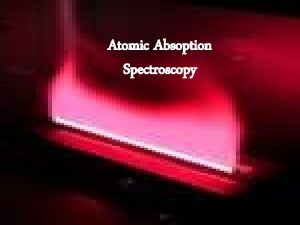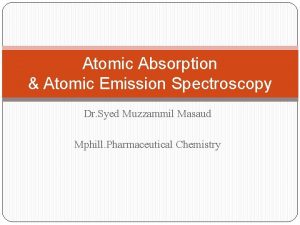Lecture 1 2 Introduction to Atomic Spectroscopy o
























- Slides: 24

Lecture 1 -2: Introduction to Atomic Spectroscopy o Line spectra Bulb o Emission spectra Sun o Absorption spectra Na o Hydrogen spectrum o Balmer Formula Emission spectra H Hg Cs o Bohr’s Model Absorption spectra Chlorophyll Diethylthiacarbocyaniodid Diethylthiadicarbocyaniodid PY 3 P 05

Types of Spectra o Continuous spectrum: Produced by solids, liquids & dense gases produce - no “gaps” in wavelength of light produced: o Emission spectrum: Produced by rarefied gases – emission only in narrow wavelength regions: o Absorption spectrum: Gas atoms absorb the same wavelengths as they usually emit and results in an absorption line spectrum: PY 3 P 05

Emission and Absorption Spectroscopy Gas cloud 3 1 2 PY 3 P 05

Line Spectra o Electron transition between energy levels result in emission or absorption lines. o Different elements produce different spectra due to differing atomic structure. H He C PY 3 P 05

Emission/Absorption of Radiation by Atoms o Emission/absorption lines are due to radiative transitions: 1. Radiative (or Stimulated) absorption: Photon with energy (E = h = E 2 - E 1) excites electron from lower energy level. E =h E 2 E 1 Can only occur if E = h = E 2 - E 1 o Radiative recombination/emission: Electron makes transition to lower energy level and emits photon with energy h ’ = E 2 - E 1. PY 3 P 05

Emission/Absorption of Radiation by Atoms o Radiative recombination can be either: a) Spontaneous emission: Electron minimizes its total energy by emitting photon and making transition from E 2 to E 1. E 2 E 1 E ’ =h ’ Emitted photon has energy E ’ = h ’ = E 2 - E 1 b) Stimulated emission: If photon is strongly coupled with electron, cause electron to decay to lower energy level, releasing a photon of the same energy. E =h E 2 E ’ =h ’ E 1 E =h Can only occur if E = h = E 2 - E 1 Also, h ’ = h PY 3 P 05

Simplest Atomic Spectrum: Hydrogen o In ~1850’s, optical spectrum of hydrogen was found to contain strong lines at 6563, 4861 and 4340 Å. H H 6563 (Å) 4861 H 4340 o Lines found to fall closer and closer as wavelength decreases. o Line separation converges at a particular wavelength, called the series limit. o Balmer found that the wavelength of lines could be written where n is an integer >2, and RH is the Rydberg constant. PY 3 P 05

Simplest Atomic Spectrum: Hydrogen o If n =3, => Å o Called H - first line of Balmer series. o Other lines in Balmer series: Name Transitions Wavelength (Å) H 3 -2 6562. 8 H 4 -2 4861. 3 H 5 -2 4340. 5 Highway 6563 in New Mexico o Balmer Series limit occurs when n . Å PY 3 P 05

Simplest Atomic Spectrum: Hydrogen o Other series of hydrogen: Lyman UV nf = 1, ni 2 Balmer Visible/UV nf = 2, ni 3 Paschen IR nf = 3, ni 4 Brackett IR nf = 4, ni 5 Pfund IR nf = 5, ni 6 o Rydberg showed that all series above could be reproduced using Series Limits o Series limit occurs when ni = ∞, nf = 1, 2, … PY 3 P 05

Simplest Atomic Spectrum: Hydrogen o Term or Grotrian diagram for hydrogen. o Spectral lines can be considered as transition between terms. o A consequence of atomic energy levels, is that transitions can only occur between certain terms. Called a selection rule. Selection rule for hydrogen: n = 1, 2, 3, … PY 3 P 05

Bohr Model for Hydrogen o Simplest atomic system, consisting of single electron-proton pair. o First model put forward by Bohr in 1913. He postulated that: 1. Electron moves in circular orbit about proton under Coulomb attraction. 2. Only possible for electron to orbits for which angular momentum is quantised, ie. , n = 1, 2, 3, … 3. Total energy (KE + V) of electron in orbit remains constant. 4. Quantized radiation is emitted/absorbed if an electron moves changes its orbit. PY 3 P 05

Bohr Model for Hydrogen o Consider atom consisting of a nucleus of charge +Ze and mass M, and an electron on charge -e and mass m. Assume M>>m so nucleus remains at fixed position in space. o As Coulomb force is a centripetal, can write (1) o As angular momentum is quantised (2 nd postulate): o Solving for v and substituting into Eqn. 1 => n = 1, 2, 3, … (2) o The total mechanical energy is: n = 1, 2, 3, … (3) o Therefore, quantization of AM leads to quantisation of total energy. PY 3 P 05

Bohr Model for Hydrogen o Substituting in for constants, Eqn. 3 can be written and Eqn. 2 can be written e. V where a 0 = 0. 529 Å = “Bohr radius”. o Eqn. 3 gives a theoretical energy level structure for hydrogen (Z=1): o For Z = 1 and n = 1, the ground state of hydrogen is: E 1 = -13. 6 e. V PY 3 P 05

Bohr Model for Hydrogen o The wavelength of radiation emitted when an electron makes a transition, is (from 4 th postulate): or (4) where o Theoretical derivation of Rydberg formula. o Essential predictions of Bohr model are contained in Eqns. 3 and 4. PY 3 P 05

Correction for Motion of the Nucleus o Spectroscopically measured RH does not agree exactly with theoretically derived R∞. o But, we assumed that M>>m => nucleus fixed. In reality, electron and proton move about common centre of mass. Must use electron’s reduced mass ( ): o As m only appears in R∞, must replace by: o It is found spectroscopically that RM = RH to within three parts in 100, 000. o Therefore, different isotopes of same element have slightly different spectral lines. PY 3 P 05

Correction for Motion of the Nucleus o Consider 1 H (hydrogen) and 2 H (deuterium): cm-1 o Using Eqn. 4, the wavelength difference is therefore: o Called an isotope shift. o H and D are separated by about 1Å. o Intensity of D line is proportional to fraction of D in the sample. Balmer line of H and D PY 3 P 05

Spectra of Hydrogen-like Atoms o Bohr model works well for H and H-like atoms (e. g. , 4 He+, 7 Li 2+, 7 Be 3+, etc). o Spectrum of 4 He+ is almost identical to H, but just offset by a factor of four (Z 2). o For He+, Fowler found the following in stellar spectra: Z=1 H 0 20 13. 6 e. V n 2 1 Z=2 He+ n 3 2 Z=3 Li 2+ n 4 3 2 o See Fig. 8. 7 in Haken & Wolf. Energy (e. V) 40 60 54. 4 e. V 1 80 100 120 1 122. 5 e. V PY 3 P 05

Spectra of Hydrogen-like Atoms o Hydrogenic or hydrogen-like ions: o o He+ (Z=2) Li 2+ (Z=3) Be 3+ (Z=4) … Z=1 H 0 Hydrogenic isoelectronic sequences 20 13. 6 e. V n 2 1 Z=2 He+ n Z=3 Li 2+ 3 2 n 4 3 2 Energy (e. V) o From Bohr model, the ionization energy is: 40 60 54. 4 e. V 1 80 100 E 1 = -13. 59 Z 2 e. V 120 1 122. 5 e. V o Ionization potential therefore increases rapidly with Z. PY 3 P 05

Implications of Bohr Model o We also find that the orbital radius and velocity are quantised: and o Bohr radius (a 0) and fine structure constant ( ) are fundamental constants: and o Constants are related by o With Rydberg constant, define gross atomic characteristics of the atom. Rydberg energy RH 13. 6 e. V Bohr radius a 0 5. 26 x 10 -11 m Fine structure constant 1/137. 04 PY 3 P 05

Exotic Atoms o Positronium o electron (e-) and positron (e+) enter a short-lived bound state, before they annihilate each other with the emission of two -rays (discovered in 1949). o Parapositronium (S=0) has a lifetime of ~1. 25 x 10 -10 s. Orthopositronium (S=1) has lifetime of ~1. 4 x 10 -7 s. o Energy levels proportional to reduced mass => energy levels half of hydrogen. o Muonium: o Replace proton in H atom with a meson (a “muon”). o Bound state has a lifetime of ~2. 2 x 10 -6 s. o According to Bohr’s theory (Eqn. 3), the binding energy is 13. 5 e. V. o From Eqn. 4, n = 1 to n = 2 transition produces a photon of 10. 15 e. V. o Antihydrogen: o Consists of a positron bound to an antiproton - first observed in 1996 at CERN! o Antimatter should behave like ordinary matter according to QM. o Have not been investigated spectroscopically … yet. PY 3 P 05

Failures of Bohr Model o Bohr model was a major step toward understanding the quantum theory of the atom - not in fact a correct description of the nature of electron orbits. o Some of the shortcomings of the model are: 1. Fails describe why certain spectral lines are brighter than others => no mechanism for calculating transition probabilities. 2. Violates the uncertainty principal which dictates that position and momentum cannot be simultaneously determined. o Bohr model gives a basic conceptual model of electrons orbits and energies. The precise details can only be solved using the Schrödinger equation. PY 3 P 05

Failures of Bohr Model o From the Bohr model, the linear momentum of the electron is o However, know from Hiesenberg Uncertainty Principle, that o Comparing the two Eqns. above => p ~ n p o This shows that the magnitude of p is undefined except when n is large. o Bohr model only valid when we approach the classical limit at large n. o Must therefore use full quantum mechanical treatment to model electron in H atom. PY 3 P 05

Hydrogen Spectrum o Transitions actually depend on more than a single quantum number (i. e. , more than n). o Quantum mechanics leads to introduction on four quntum numbers. o Principal quantum number: n o Azimuthal quantum number: l o Magnetic quantum number: ml o Spin quantum number: s o Selection rules must also be modified. PY 3 P 05

Atomic Energy Scales Energy scale Energy (e. V) Effects Gross structure 1 -10 electron-nuclear attraction Electron kinetic energy Electron-electron repulsion Fine structure 0. 001 - 0. 01 Spin-orbit interaction Relativistic corrections Hyperfine structure 10 -6 - 10 -5 Nuclear interactions PY 3 P 05
 Atomic emission spectroscopy lecture notes
Atomic emission spectroscopy lecture notes Prinsip alat aas
Prinsip alat aas Total consumption burner
Total consumption burner Fluorescence spectroscopy - ppt
Fluorescence spectroscopy - ppt Atomic emission spectroscopy principle
Atomic emission spectroscopy principle Atomic absorption spectroscopy history
Atomic absorption spectroscopy history Difference between atomic and molecular spectroscopy
Difference between atomic and molecular spectroscopy Erzeng xue
Erzeng xue Photometry
Photometry Interferences of atomic absorption spectroscopy
Interferences of atomic absorption spectroscopy Atomic absorption spectroscopy
Atomic absorption spectroscopy Atomic fluorescence spectroscopy principle
Atomic fluorescence spectroscopy principle Schematic diagram of atomic absorption spectroscopy
Schematic diagram of atomic absorption spectroscopy Application of aas
Application of aas 01:640:244 lecture notes - lecture 15: plat, idah, farad
01:640:244 lecture notes - lecture 15: plat, idah, farad Is atomic mass and relative atomic mass the same
Is atomic mass and relative atomic mass the same Atomic size vs atomic radius
Atomic size vs atomic radius Atom size trend periodic table
Atom size trend periodic table Abundance calculation chemistry
Abundance calculation chemistry Atomic
Atomic Atomic number vs atomic radius
Atomic number vs atomic radius Applications of uv spectroscopy
Applications of uv spectroscopy Charge d'un électron
Charge d'un électron Introduction to biochemistry lecture notes
Introduction to biochemistry lecture notes Introduction to psychology lecture
Introduction to psychology lecture
